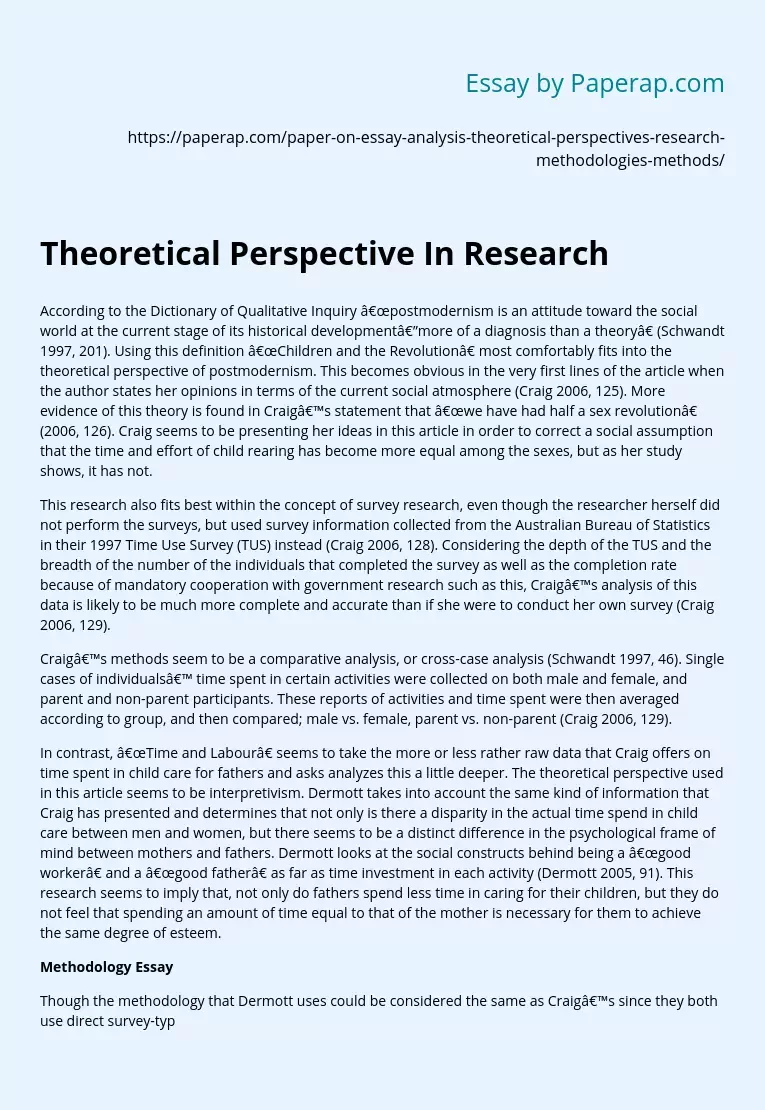Theoretical Perspective In Research
According to the Dictionary of Qualitative Inquiry “postmodernism is an attitude toward the social world at the current stage of its historical development—more of a diagnosis than a theory” (Schwandt 1997, 201). Using this definition “Children and the Revolution” most comfortably fits into the theoretical perspective of postmodernism. This becomes obvious in the very first lines of the article when the author states her opinions in terms of the current social atmosphere (Craig 2006, 125). More evidence of this theory is found in Craig’s statement that “we have had half a sex revolution” (2006, 126).
Craig seems to be presenting her ideas in this article in order to correct a social assumption that the time and effort of child rearing has become more equal among the sexes, but as her study shows, it has not.
This research also fits best within the concept of survey research, even though the researcher herself did not perform the surveys, but used survey information collected from the Australian Bureau of Statistics in their 1997 Time Use Survey (TUS) instead (Craig 2006, 128).
Considering the depth of the TUS and the breadth of the number of the individuals that completed the survey as well as the completion rate because of mandatory cooperation with government research such as this, Craig’s analysis of this data is likely to be much more complete and accurate than if she were to conduct her own survey (Craig 2006, 129).
Craig’s methods seem to be a comparative analysis, or cross-case analysis (Schwandt 1997, 46). Single cases of individuals’ time spent in certain activities were collected on both male and female, and parent and non-parent participants.
These reports of activities and time spent were then averaged according to group, and then compared; male vs. female, parent vs. non-parent (Craig 2006, 129).
In contrast, “Time and Labour” seems to take the more or less rather raw data that Craig offers on time spent in child care for fathers and asks analyzes this a little deeper. The theoretical perspective used in this article seems to be interpretivism. Dermott takes into account the same kind of information that Craig has presented and determines that not only is there a disparity in the actual time spend in child care between men and women, but there seems to be a distinct difference in the psychological frame of mind between mothers and fathers. Dermott looks at the social constructs behind being a “good worker” and a “good father” as far as time investment in each activity (Dermott 2005, 91). This research seems to imply that, not only do fathers spend less time in caring for their children, but they do not feel that spending an amount of time equal to that of the mother is necessary for them to achieve the same degree of esteem.
Methodology Essay
Though the methodology that Dermott uses could be considered the same as Craig’s since they both use direct survey-type material straight from their participants, it would be more accurate to say that Dermott is using a heuristic inquiry approach. On the surface both Craig and Dermott are investigating the same phenomenon, just on opposite ends of the spectrum. However, Dermott’s departure from simply analyzing the hours spent in childcare can be seen in such places as on pages 93-94 where she begins by stating that “Feeling responsible” was one cited reason why the men participating in the study chose to spend more time at work than with their children. Dermott’s investigation of why there is a discrepancy between the role of men and women in rearing children is what makes her work more heuristic than simply a survey.
Dermott’s methods are also in contrast to Craig’s since her methodology requires a deeper, more personal look at her subjects than a collection of recorded numbers can provide. Clearly, through various quotes taken directly from her subjects, Dermott has used an interview method to obtain her research material.
When comparing the two articles, Crotty’s discussion of the four elements of social research becomes quite poignant (Crotty 1998, 1). Ultimately Craig and Dermott are researching almost identical topics, though they are focusing on the different genders in the same topic. Craig’s approach expresses the discrepancy, but focuses on showing that raising children is, in fact, a major financial and temporal burden, and the women take the brunt of the temporal responsibility as well as play a major support role in the financial responsibility. She shows how this has actually evolved over the years through the change in women’s roles in society. Dermott, on the other hand, addresses the same topic, but explores the reasons behind the disparity. Interestingly enough, Dermott’s research serves as an extension of Craig’s work, though it also shows that the men have the same problem with the one-sided sexual revolution by stating that, though men are being increasingly expected to spend more time in child care their roles as the main support of a family have not changed enough to keep up with this trend (Dermott 2005, 92). This stands both in opposition and in explanation of Craig’s statement that though women have entered the workforce in huge numbers the expectation of them taking the majority of the domestic and child care responsibility has not changed (Craig 2006, 126).
It is because of the subtleties in the development of the four elements that these two researchers could approach practically the identical topic and yet develop such different perspectives that provide unique information about the topic.
Theoretical Perspective In Research. (2019, Dec 05). Retrieved from https://paperap.com/paper-on-essay-analysis-theoretical-perspectives-research-methodologies-methods/

